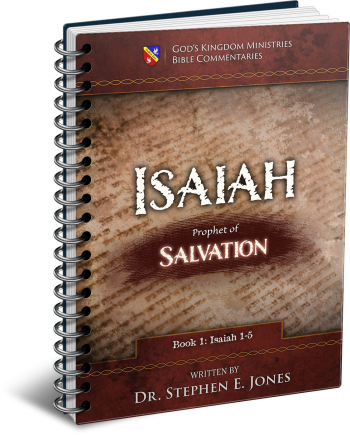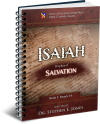Latest Posts
View the latest posts in an easy-to-read list format, with filtering options.

Isaiah is the prophet of Salvation. He is also known as the truly "Universalist" prophet, by which is meant that He makes it clear that salvation is extended equally to all nations and not just to Israel. He lived to see the fall of Israel and the deportation of the Israelites to Assyria, and he prophesied of their "return" to God (through repentance). He is truly a "major prophet" whose prophecies greatly influenced the Apostle Paul in the New Testament.
Category - Bible Commentaries

In Isaiah 3:16-26 the prophet alternates between individual women (3:16-24) and the city itself (3:25, 26), which is also pictured as a woman. Hence, not only will individual women and wives be found desolate after so many men are killed in the coming war, but the city itself will be desolate among other cities in the region.
After speaking of the desolation of Jerusalem, which is pictured as a lonely woman dressed in sackcloth, Isaiah 4:1 says,
1 For seven women will take hold of one man in that day, saying, “We will eat our own bread and wear our own clothes, only let us be called by your name; take away our reproach!”
The prophet’s metaphor is of a land with few men left, where seven women would need support, protection, and shelter and would give themselves in marriage to one man as self-supporting wives. In normal times, a man would give a dowry to the parents of his spouse, which served as her security (or trust account) in case her husband died or divorced her.
But in times of trouble and war, most of the men were often killed in battle, leaving an abundance of women to fend for themselves. In such times, polygamy became a practical necessity for the nation’s survival.
Such was the picture painted by the prophet in Jerusalem’s coming desolation. Such a marriage described in Isaiah 4:1 does not reflect a New Covenant marriage but an Old Covenant accommodation that was necessary when Jerusalem was destroyed for its rebellion against God. The situation was anything but ideal, for they were said to be under “reproach.”
Neither is the “one man” meant to describe the Messiah, for the Messiah was to marry the bride under a New Covenant marriage, as Isaiah 62:4 describes later. Isaiah 4:1 describes Jerusalem and its people in a state of desolation, not in a place of restoration.
Yet there is hope in the future through the Messiah who was yet to come. Isaiah 4:2 says,
2 In that day the Branch [zemach] of the Lord will be beautiful and glorious, and the fruit of the earth will be the pride and the adornment of the survivors [peleytah, “escaped ones, survivors, remnant”] in Israel.
This “Branch” prophecy is the first of its kind in reference to the Messiah. A century later, the prophet Jeremiah would pick up this theme and give us more details. Jer. 23:5 says,
5 “Behold, the days are coming,” declares the Lord, “When I will raise up for David a righteous Branch [Zemach]; and He will reign as King and act wisely and do justice and righteousness in the land.”
Jeremiah identifies this Branch as being from the house of David who was to “reign as King.” After Jerusalem’s captivity, the prophet Zechariah prophesied to the remnant that had returned to the land, saying in Zech. 6:12, 13,
12 Then say to him, “Thus says the Lord of hosts, ‘Behold, a man whose name is Branch [Zemach], for He will branch out [zamach] from where He is; and He will build the temple of the Lord. 13 Yes, it is He who will build the temple of the Lord, and He who will bear the honor and sit and rule on His throne. Thus, He will be a priest on His throne, and the counsel of peace will be between the two offices’.”
Zechariah tells us that this man named Branch will build the temple. Earlier, in Zechariah 3:8, the prophet links this Branch to Joshua, the high priest of that time, who served as a type of Yeshua, or Jesus Christ. Zechariah thus prophesies of the final Temple that Christ was to build. It was the temple made of living stones that is described in Eph. 2:20-22, in which He will be the high priest of the Order of Melchizedek.
So Jeremiah says the Branch will be the King; Zechariah says the Branch will be the “priest on His throne” and the builder of the final temple wherein He will minister. Between the two, the Branch is the King-Priest of the Melchizedek Order.
Yet Isaiah was the first to refer to the Messiah by the name Zemach. When he writes, “In that day,” the prophet was referring to the days of the Messiah, not to the time of desolation that Jerusalem was about to experience. The fruit of the Branch was to be its “pride” and “adornment,” whereas Jerusalem itself was to be an unfruitful tree that Jesus would curse in Matt. 21:19.
This fruitful Branch was also linked to the “survivors of Israel,” says the prophet. Although Isaiah did not explain this in any detail, Jesus Himself enlarged upon this in John 15:1, saying, “I am the true vine, and My Father is the vinedresser.” He then speaks of His disciples as being branches attached to the true Vine. These who bear fruit are Isaiah’s “survivors of Israel.”
As we will see later, the prophet speaks of fruit in Isaiah 27:6,
6 In the days to come Jacob will take root, Israel will blossom and sprout, and they will fill the whole world with fruit.
Yet it is not until the New Testament writings that we see this theme developed clearly. John the Baptist was sent as a fruit inspector (Matt. 3:10) to see if the fig tree of Judah would bring forth the fruit of the Kingdom. He found none on the tree itself, although there were individuals (a minority, or remnant) that were indeed fruitful.
After John was executed by Herod, Jesus became the chief Fruit Inspector for the next three years (Luke 13:6-9). At the end of His ministry, He cursed the fig tree for its lack of fruit (Matt. 21:19).
Then in Jesus’ parable in Matt. 21:33-43, He told the parable of the vineyard, based on Isaiah 5, which we will soon study. The parable showed that Joshua (a type of Jesus Christ) planted a vineyard in the land of Canaan. It was the Kingdom itself, and it was expected to bring forth fruit. However, the vineyard keepers stole the fruit for themselves and refused to give it to the Owner of the vineyard. The Owner sent His servants, the prophets, but the vineyard keepers beat them and stoned them.
Finally, the Owner sent His Son, but when the vineyard keepers recognized Him as the Son and Heir, they plotted to kill Him in order to steal the entire vineyard for themselves. The verdict, then, was that these vineyard keepers were to be fired, and the vineyard was to be “given to a people producing the fruit of it” (Matt. 21:43).
In other words, the custodians of the Kingdom were to be believers in Christ who were producing the fruit of the Spirit—not those who had usurped the vineyard for themselves and who refused to bear fruit. Hence, there are two “trees,” one that bears fruit and another that bears leaves but is fruitless.
It is important to understand the full story, because the Old Testament prophets do not distinguish between the two Jerusalems. As we will see, the earthly and heavenly cities are two trees, one barren and the other fruitful. Each has a different destiny, which is clearly shown in the New Testament, where the two cities are distinguished clearly.
Those who do not understand the difference between the two cities cannot possibly understand how to interpret the Old Testament prophecies. This is one of the great keys to understanding Scripture. It is a key that has been lost in the past two centuries, and only a remnant now has any understanding of this.